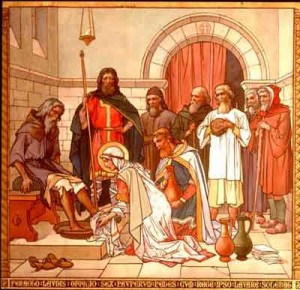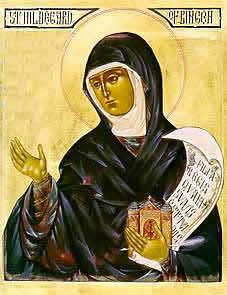 December 16, 2011. (Romereports.com)
December 16, 2011. (Romereports.com)
Benedict XVI is set to appoint Hildegard of Bingen as a Doctor of the Church in October of 2012. She was a German Benedictine nun and was known for her visions and prophecies.
Hildegard of Bingen lived in the twelfth century. In addition to being a nun, she was a composer, philosopher, physicist and ecologist. A multi-talented woman, and a pioneer for many of these fields during the Middle Ages.She came from a wealthy family and when she was only eight years old was sent to study in a monastery. She eventually decided to become a nun and later became an abbess.
Her visions and prophecies were recognized by the pope during that time, allowing her to speak about them publicly.
Since she has not been officially canonized, the ceremony is likely to take place before the pope names her as a Doctor of the Church in October.
Benedict XVI dedicated several of his general audiences to this German nun, saying that she “served the Church in an age in which it was wounded by the sins of priests and laityâ€.
Benedict XVI
September 8, 2010Â
“She brought a woman’s insight to the mysteries of the faith. In her many works she contemplated the mystic marriage between God and humanity accomplished in the Incarnation, as well as the spousal union of Christ and the Church. She also explored the vital relationship between God and creation, and our human calling to give glory to God by a life of holiness and virtue.â€So far there are 33 doctors of the Church, only 3 of whom are women. During World Youth Day, Benedict XVI also announced that the Spanish San Juan de Avila would also be appointed as a Doctor of the Church.
With this appointment, the Church recognizes a person’s contribution to Catholic theology, which is still felt despite the passage of time.
Tags: benedict xvi, benedictine, catholic, catholic podcast, catholic prayer, cathollc spirituality, Hildegard of Bingen, mystic of the Church, st hildegard of bingen
This entry was posted on Wednesday, January 4th, 2012 at 8:47 am
You can follow any responses to this entry through the RSS 2.0 feed.
.
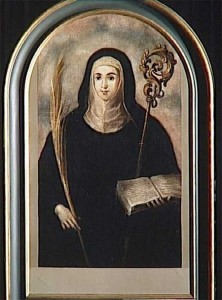 see also Pope Benedict’s teachings on St. Gertrude on the Discerning Hearts Holy Women page
see also Pope Benedict’s teachings on St. Gertrude on the Discerning Hearts Holy Women page
(1256-1302 A.D.) Few men have merited the title, “the Great”; fewer women. I know of only one nun so honored, St. Gertrude of Helfta, a mystic whose spiritual writings have remained influential up to the present.
Nothing is known of this German woman’s family background. When five years old, she was entrusted to the sisters of Helfta Abbey to be educated. From a very young age she gave evidence of her brilliance and quickly outstripped her companions. In her teen years she asked to join the community. Therefore, she probably spent her whole life from childhood on within the abbey walls.
Her love for secular studies made the common life wearisome, pride and vanity ate away at her soul and she soon became an unhappy young woman until Christ appeared to her. The day was branded in her memory, it was in her 26th year, when as she says “in a happy hour, at the beginning of twilight, thou O God of truth, more radiant than any light, yet deeper than any secret thing, determined to dissolve the obscurity of my darkness.” From then on her biographer tells us “she became a theologian instead of a grammarian.” She did not give up her intellectual ardor but now, all her labors were for her sisters, to cure what she termed “the wound of ignorance”. Her many gifts and mystical graces did not prevent her from giving herself wholeheartedly to the common life with its joys and sorrows. In fact many of her special graces came to her as she took part in the ordinary routine of convent life. She felt keenly for those whose burdens involved them in distracting duties, for example those responsible for meeting the debts of the monastery.
She prayed that they might have more time to pray and fewer distractions. The Lord’s answered “It does not matter to me whether you perform spiritual exercises or manual labor, provided only that your will is directed to me with a right intention. If I took pleasure only in your spiritual exercises, I should certainly have reformed human nature after Adam’s fall so that it would not need food, clothing or the other things that man must find or make with such effort.”
Many of her writings are lost, but fortunately she left to the world an abundance of spiritual joy in her book The Herald of Divine Love, in which she tells of the visions granted her by our divine Lord. She wrote this excellent, small book because she was told that nothing was given to her for her own sake only. Her Exercises is an excellent treatise on the renewal of baptismal vows, spiritual conversion, religious vows, love, praise, gratitude to God, reparation, and preparation for death.
She began to record her supernatural and mystical experiences in what eventually became her Book of Extraordinary Grace (Revelation of Saint Gertrude), together with Mechtilde’s mystical experiences Liber Specialis Gratiae, which Gertrude recorded. Most of the book was actually written by others based on Gertrude’s notes. She also wrote with or for Saint Mechtilde a series of prayers that became very popular, and through her writings helped spread devotion to the Sacred Heart (though it was not so called until revealed to St. Margaret Mary Alocoque).
Gertrude is inseparably associated with the devotion to the Sacred Heart. The pierced hear
t of Jesus embodied for her the Divine Love, an inexhaustible fountain of redemptive life. Her visions and insights in connection with the Heart of Jesus are very enlightening. In one such intellectual vision, she perceived the unceasing love of Christ for us in two pulsations of his Heart – one accomplished the conversion of sinners, the other the sanctification of the just. Just as our own faithful heart keeps right on whether we advert to it or not, these pulsations will endure till the end of time despite the vicissitudes of history.
Our Lord wishes people to pray for the souls in purgatory. He once showed Gertrude a table of gold on which were many costly pearls. The pearls were prayers for the holy souls. At the same time the saint had a vision of souls freed from suffering and ascending in the form of bright sparks to heaven.
In one Vision, Our Lord tells Gertrude that he longs for someone to ask Him to release souls from purgatory, just as a king who imprisons a friend for justice’s sake hopes that someone will beg for mercy for his friend. Jesus ends with:
“I accept with highest pleasure what is offered to Me for the poor souls, for I long inexpressibly to have near Me those for whom I paid so great a price. By the prayers of thy loving soul, I am induced to free a prisoner from purgatory as often as thou dost move thy tongue to utter a word of prayer.” (more…)
Tags: benedictine, catholic, catholic podcast, catholic prayer, cathollc spirituality, devotion, family, jesus christ, love, mystic of the Church, mystical experiences, sacred heart, sacred heart of jesus, spiritual exercises, spiritual writings, st gertrude, women of the middle ages
This entry was posted on Wednesday, November 16th, 2011 at 2:30 am
You can follow any responses to this entry through the RSS 2.0 feed.
A Queen of Scotland!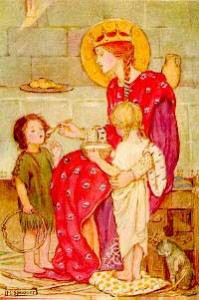
Margaret was born c. 1045 and was the niece of King Edward the Confessor of England. She was raised in Hungary and lived with her exiled father, Edward Atheling, her mother, Agatha, her brother, Edgar, and her sister, Christian. They returned to England in 1054. Early chronicles tell us that she read the scriptures in Latin, learned French and was trained in English needlework.
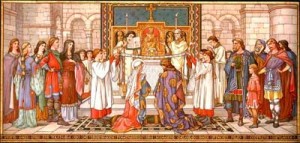 Marriage of St Margaret
Marriage of St MargaretMargaret married Malcolm III ‘Canmore’ of Scotland in c.1070. Margaret would have been about 24 years of age and Malcolm about 47. Ancient chronicles tell us that Margaret was more prepared for the cloister than the crown. However, Malcolm won her over and they were married in Dunfermline, then the seat of the Scottish kings.
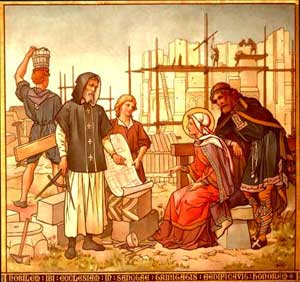
Margaret had a significant influence on early Scotland. Although she was a patron of the existing celtic church, she also introduced to Scotland the Benedictines from Canterbury and had the Priory Church built which would eventually become Dunfermline Abbey. Margaret also had a chapel built at Edinburgh Castle and the church at Iona rebuilt after Viking attacks.
Washing the feet of the poor
Margaret was very pious and carried out many works of charity. She visited and cared for the sick and had hostels built for the poor. It was her custom that the poor should visit her every morning and be seated around her to receive alms. (more…)
Tags: benedictine, catholic, catholic podcast, catholic prayer, cathollc spirituality, celtic church, england, Malcolm III, mother, scotland, st margaret, St Margaret Margaret, St. Margaret of Scotland, women of the middle ages
This entry was posted on Wednesday, November 16th, 2011 at 12:04 am
You can follow any responses to this entry through the RSS 2.0 feed.


